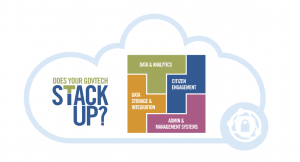
Today’s Buzz is by Meredith Trimble, Sr. Content Specialist with Tyler Technologies, Inc., and former Acting Chair, Farmington, CT Town Council (Twitter, LinkedIn)
What I’m reading: For how to pack maximum meaning into every sentence, Bill Bryson’s newest: The Body: A Guide for Occupants
What I’m watching: NHL Stanley Cup Playoffs!
What I’m listening to: The Tyler Tech Podcast for new generational research, COVID-19’s impact on mental health, the best Kansas City barbecue, and more of interest to #localgov
Many industries have digital strategies. There’s the well-known marketing technology “MarTech Stack,” the education technology “EdTech Stack,” and the financial technology “FinTech Stack.” These are ideas, not products, that help industries find the right matrix of existing and new technology to improve and automate business process and improve stakeholder experiences.
Traditional Silos
When we think about government technology, the most common experience is that city and county systems are purchased at a departmental level, beginning and remaining siloed. For example, a government’s public safety dispatching system and the records management system may be different. Court case management and financial ERP systems are likely built on different platforms. The same is true for programs used by planning departments, deed offices, public works, parks & rec, and others.
As these systems were purchased or built, the emphasis was on internal operations: “does this work for my department’s employees?” The result is that any system’s primary goal is to serve one area’s front-line employees. That’s a valid starting point. Innovation in government service, however, requires something more.
Why? Simply put, every department in a government can’t come up with different answers and survive a crisis or achieve efficient, successful operations. There must be a coordinated strategy in which a government is examining – and meeting – the desired experience for all true stakeholders through its digital infrastructure. In addition, COVID-19 has necessitated enhanced citizen engagement to maintain business continuity, impart emergency information, and gather data in real time and from remote locations.
The GovTech Stack
The local government adaptation of the earlier-mentioned digital strategies is the “GovTech Stack.” Again, this is a long-term strategy or approach rather than a pre-packaged solution. A solid GovTech Stack requires that governments think beyond the department level to determine how any system:
- Serves business partners
- Serves the public
- Provides internal and external decision-makers with actionable insight
- Ensures security and access to the most up-to-date information
These points expand the definition of “stakeholder” to ensure full, meaningful connectivity; the type of connectivity necessary to move the needle on issues and solve real problems. A complete GovTech Stack contains:
- Data & Analytics: Surfacing meaningful, easy-to-understand data and enhancing access to it informs better government decisions for improved operations and smarter resource allocation. Transparency enables an informed citizenry and open data paves the way for problem-solving partnerships.
- Citizen Engagement: Expanding virtual options and two-way citizen engagement tools provides uninterrupted service to residents at their convenience while maintaining business operations in any circumstances. Real-time civic experiences connect the public to a government’s services, resources, and information in a way that harnesses participation for stronger communities.
- Data Storage & Integration: Modern data storage and integration allows agencies to track, collaborate, and report on the data that drives activities forward. Automated workflows remove manual processes, eliminate errors, and strengthen data’s integrity and accessibility.
- Admin & Management Systems: Integrated administrative and business management technology foundations power mission-critical operations and break down silos for greater efficiency and solution-bearing connections.
- Cloud: Enterprise-wide cloud architecture provides 24/7 remote access to data and systems, and mitigates security risk with built-in disaster recovery, security compliance, and remote updates. The cloud improves the agility of government to respond quickly to crises and rapidly evolving situations. Cloud benefits include a reduced IT footprint, capital and infrastructure savings, and streamlined workflows with up-to-date information accessible to all stakeholders.
- Cybersecurity: An advanced cybersecurity culture is necessary to keep up with the evolving threat landscape. A robust cybersecurity strategy includes privacy controls, employee education, and managed threat detection.
Each of these components must take into account interoperability across and even beyond the jurisdiction for a mature, integrated GovTech Stack. If any one piece is missing, the stack won’t hold up, leaving important information, insight, or efficiencies to fall through the cracks. That said, this shouldn’t be seen as a huge capital project that happens all at once. Each government should assess its progress in the above areas and develop a maturity strategy whereby components evolve over time and provide cost-saving returns on investment along the way.
Future-Ready Tech Confluence
Without a full, modern tech infrastructure in place, sharing data between multiple systems is complicated at best. Bottlenecks, miscommunications, operational delays, security vulnerabilities, and decisions based on anecdote, not fact, remain the norm.
When process and data integration are achieved enterprise-wide, maximum levels of efficiency and insight naturally follow. The key is the technology confluence that eliminates silos and builds all systems on the fundamental elements of a complete GovTech Stack. Built thoughtfully over time, this will shore up governments for crises while effectively serving all stakeholders in the broadest sense of the word.
